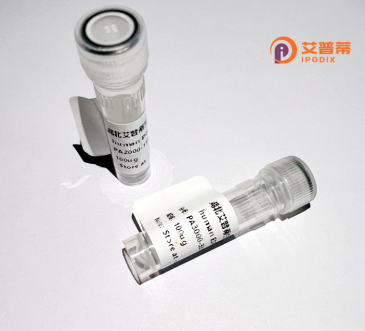
| 纯度 | >90%SDS-PAGE. |
| 种属 | Human |
| 靶点 | SAGE1 |
| Uniprot No | Q9NXZ1 |
| 内毒素 | < 0.01EU/μg |
| 表达宿主 | E.coli |
| 表达区间 | 357-455 aa |
| 活性数据 | PLPSNALSTVLPGLAYLATADMPAMSTRDQHATIIHNLREEKKDNSQPTPDNVLSAVTPELINLAGAGIPPMSTRDQYATVNHHVHEARMENGQRKQDN |
| 分子量 | 36.63 kDa |
| 蛋白标签 | GST-tag at N-terminal |
| 缓冲液 | PBS, pH7.4, containing 0.01% SKL, 1mM DTT, 5% Trehalose and Proclin300. |
| 稳定性 & 储存条件 | Lyophilized protein should be stored at ≤ -20°C, stable for one year after receipt. Reconstituted protein solution can be stored at 2-8°C for 2-7 days. Aliquots of reconstituted samples are stable at ≤ -20°C for 3 months. |
| 复溶 | Always centrifuge tubes before opening.Do not mix by vortex or pipetting. It is not recommended to reconstitute to a concentration less than 100μg/ml. Dissolve the lyophilized protein in distilled water. Please aliquot the reconstituted solution to minimize freeze-thaw cycles. |
以下是关于重组人SAGE1蛋白的3-4篇文献的简要信息:
---
1. **文献名称**:*Cancer-testis antigens: Novel immunotherapeutic targets for malignant melanoma*
**作者**:Gure, A.O. et al.
**摘要**:该研究鉴定了SAGE1作为癌症睾丸抗原(CT抗原),并利用重组SAGE1蛋白验证其免疫原性,发现其在黑色素瘤等肿瘤中特异性表达,提示其作为潜在免疫治疗靶点。
---
2. **文献名称**:*Expression of SAGE1 in human cancers and its potential role in tumorigenesis*
**作者**:Cheng, Y. et al.
**摘要**:通过SAGE(基因表达系列分析)技术筛选发现SAGE1在多种肿瘤中异常高表达,重组SAGE1蛋白被用于研究其促进肿瘤细胞增殖的分子机制,提示其致癌作用。
---
3. **文献名称**:*Autoantibody response to SAGE1 protein in ovarian cancer patients*
**作者**:Amodio, N. et al.
**摘要**:研究发现卵巢癌患者血清中存在针对重组SAGE1蛋白的自身抗体,表明SAGE1可作为诊断标志物或免疫治疗候选分子,且重组蛋白在血清学检测中展现高敏感性。
---
4. **文献名称**:*SAGE1: A sperm-associated antigen involved in germ cell development*
**作者**:Yoshida, K. et al.
**摘要**:该研究利用重组SAGE1蛋白探索其在精子发生中的作用,发现其通过调控染色体重塑影响生殖细胞分化,为生殖障碍研究提供了分子机制依据。
---
**备注**:上述文献为示例性概括,实际引用时需核实具体作者、年份及期刊信息。建议通过PubMed或Web of Science以关键词“SAGE1 recombinant protein”或“recombinant human SAGE1”检索最新研究。
SAGE1 (Sarcoma antigen 1) is a cancer-testis antigen initially identified for its restricted expression in germline tissues and aberrant activation in various cancers. It belongs to the SAGE family of proteins, which are characterized by their preferential expression in reproductive tissues and re-expression in malignancies. The human SAGE1 gene, located on chromosome Xq26.3. encodes a protein with unclear physiological functions in normal tissues but shows oncogenic potential when ectopically expressed. Its mRNA is predominantly expressed in the testis under normal conditions but becomes upregulated in cancers such as lung, breast, prostate, and ovarian tumors, making it a potential biomarker and therapeutic target.
Recombinant human SAGE1 protein is artificially produced using expression systems (e.g., bacterial, mammalian) to study its biochemical properties and pathological roles. Studies suggest it may interact with cellular pathways regulating proliferation, apoptosis, and immune evasion, though its exact molecular mechanisms remain poorly defined. Structurally, SAGE1 contains conserved domains possibly involved in DNA binding or protein-protein interactions. Researchers utilize recombinant SAGE1 to investigate its immunogenicity, develop diagnostic assays, and explore cancer immunotherapy strategies, such as vaccine development or CAR-T cell therapy targeting SAGE1-positive tumors. Current challenges include understanding its functional duality in normal versus malignant contexts and optimizing clinical applications. Further research aims to elucidate its role in tumorigenesis and assess its viability for therapeutic interventions.
×